This July and August, we’re celebrating the release of Star Trek Beyond by taking a look back at the third season of the original Star Trek. Check back every Monday, Wednesday and Friday for the latest update.
Like any television, or any piece of popular culture, Star Trek is a product of its time.
That does not mean that the show speaks only to its time or that it has no relevance beyond that moment in time, but in means that the series is very much anchored in the zeitgeist of the late sixties. Sometimes that influence is obscured by advances in the intervening years, like the fascination with the novelty of transplant surgery that played out in the background of Spock’s Brain. Sometimes that tangible connection is more like ambient background noise than direct influence, as with the sense of apocalyptic dread that permeates the third season as a whole.

“You reach?”
Sometimes, however, it is impossible to look upon Star Trek as anything other than a product of the late sixties. Let That Be Your Last Battlefield was undeniably a product of 1968, with its anxiety about civil strife and civil rights, its somewhat reductive metaphor for race relations and its general production aesthetic. However, that is nothing compared to The Way to Eden, which might be the most flamboyantly and stereotypically sixties episode of the entire original run.
The Way to Eden is the episode that opens with a bunch of space!hippies staging a sit-in in the Enterprise transporter room and escalates from there.

Trippy hippie shakedown.
Star Trek has always been somewhat anxious about the hippie movement, reflecting the anxieties of a writing staff who belonged to an older generation. Gene Roddenberry, Gene L. Coon and Fred Freiberger had all served in the armed forces during the Second World War, and so were a generation removed from the flowerchildren attending Woodstock, staging university sit-ins, organising peace protests, and attempting to levitate the Pentagon. The show had touched on these ideas in a number of earlier episodes, with a recurring sense of befuddlement.
In the first season, This Side of Paradise featured literal flower children. In that episode, Kirk encounters a colony of idle layabouts living lives of absolute luxury under the influence of sinister spores. No longer motivated to work or strive, the colonists lie around and debate philosophy and Spock even falls in love. Naturally, Kirk stirs them from this illusion of paradise. While This Side of Paradise could be read in light of the first season’s many critiques of communism and socialism, it also felt like a criticism of contemporary youth in general.

Music to his ears.
This subtext became more overt early in the third season, with the production of And the Children Shall Lead. In that episode, which is very much a precursor to The Way to Eden in terms of theme, a malevolent entity manipulates a bunch of children into turning against their parents and enabling it to spread insanity across the cosmos. It is only through the intervention of James Tiberius Kirk that order is restored. The children inevitably learn the value of listening to their elders, who clearly know best.
In many ways, this reflected the contemporary sixties anxieties about the counterculture movement. Parents who had lived through the Second World War and enjoyed the relative peace and prosperity of the fifties were perplexed and confused by the fact that their children had taken to doing drugs and protesting the status quo. Coupled with the chaos of the Vietnam War and the larger strife associated with the civil rights movements, parents were understandably concerned about the world into which their children were stepping.
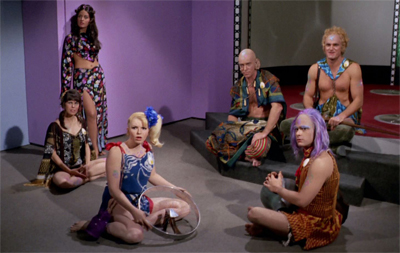
Staging a sit-in in the Enterprise transporter room.
Star Trek was late to the party. The hippie movement had enjoyed its big cultural moment in the gap between the first and second seasons of the show, the Summer of Love in which up to 75,000 young people descended upon San Francisco to live a dream of free love and free expression. Things did not necessarily work out as intended, serving to instead highlight the movement’s weaknesses more than its strengths. As Peter Braunstein argued in Forever Young:
By late summer 1967, the Flower Child charade of the hippies had begun to wilt, overheated by the media hype it had generated. The advertised lifestyle of communalism, free love, and abundant drugs had enticed young people from across America to the two largest urban hippie enclaves, San Francisco’s Haight-Ashbury and New York’s East Village, and the crescendo of immigrants soon overwhelmed the hippies’ meager resources and ad hoc organisations assembled to aid the newcomers. As a result, the “Summer of Love ’67” featured scores of young would-be hippies, many of them confused runaways, victimised by unscrupulous drug dealers, crammed in overpopulated hippie “communes”, harassed by police and municipal authorities, and objectified by commercialisation and tourism meant to capitalise on the hippie phenomenon. By summer’s end, two well-publicised murders in both coastal meccas redirected media scrutiny, which now focused on the “dark underside” of the hippie dream.
These flaws within the movement would ultimately prove fatal. Drug addiction was rampant, Speed becoming an epidemic; long-haired flower children become long-hair urchins begging for spare change. Counterculture would seemingly acknowledge the tarnished brand of the hippie by organising “The Death of the Hippie” in October 1967. The event was staged as a symbolic funeral, complete with a progression down Haight Street.
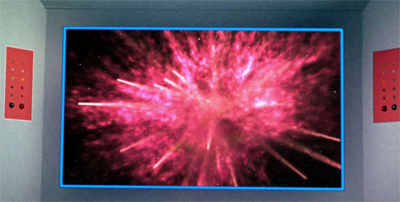
Purple haze.
Nevertheless, the hippie remained an object of popular fascination for the remainder of the decade and beyond. In fact, it could legitimately be argued that The Way to Eden exists as part of a much larger subgenre of “hippiexplotation.” To many older people and professionals, hippies were a source of endless fascination. They seemed as alien and as exotic as the characters featured here. It seemed inevitable that popular culture would latch on to the hippie, channeling the icon through a variety of pop culture lenses.
Exploitation powerhouse America International Pictures quickly cashed in on the craze. Highlights included Riot on Sunset Strip, a film that was shot and released within six weeks of the 1966 Sunset Strip curfew riots. Indeed, a young Jack Nicholson would start his career in the genre; he starred as the hippie musician “Stoney” in Psych-Out and wrote the script for The Trip. Audiences were fascinated by this movement, and studios were eager to provide a glimpse into that world. The Way to Eden is just Star Trek‘s twist on the idea.

My, what big ears you have.
Meanwhile in the real world, the “Youth International Party” adopted the nickname “yippies”, and came to be seen as a more aggressive and proactive offshoot of the movement. The yippies would sieze control of Grand Central Terminal in New York in March 1968, leading to a tactical police response and dozens of arrests. They would play a major role in the disruption of the Democratic National Convention in August 1968, which would lead to scenes of incredible violence and unrest.
The narrative that formed around the hippie movement was one of manipulation. Parents feared that their young children were being misled and manipulated by troublemakers seeking to forward their own agendas, authority figures like Timothy Leary and Abbie Hoffman abusing their positions in order to exploit teenagers and young adults not mature enough to know better. These fears would crystalise with the Tate-Labainca murders, which would lead to the arrest of manipulative cult leader Charlie Manson. Manson embodied all the elder generation’s fears about counterculture.

Just spinning their wheels.
These anxieties bled through into The Way to Eden and the way that it approached the counterculture movement by imagining a story wherein Kirk and his crew encountered what could only be described as space!hippies. As author Sean Munger points out, The Way to Eden needs to be viewed in that context:
There’s a sense in The Way to Eden that the makers of the show – writer Fontana (who took her name off the script) and director David Alexander – simply didn’t know what to make of hippies in the real world. The creatures in Severin’s crew, which includes some aliens, seem shallow and childlike, idealistic to a fault and not really in tune with how the universe really works. Their quest for Eden, which Spock says at the end of the show he admires, is portrayed as worthy, but the hippies’ motives are very reductionist, defined solely in terms of what they’re against rather than what they really believe in. Consequently the group comes off as a bunch of buffoons, as much as characters like Chekov and Kirk seem like rigid authoritarians who are incapable of “reaching” the hippies’ motivations. The two groups seem to be talking past one another. That is real. That’s the way it really was in America in 1969, especially within families where middle class suburban parents couldn’t quite understand why their son now had long hair or why their daughter started calling herself Moonbeam. This is what The Way to Eden gets right, albeit unwittingly.
The Way to Eden is extremely patronising and condescending in its portrayal of the space!hippie commune members, who are presented as reckless fools with poor judgment. However, it saves its real scorn for the figure who is misleading them. Doctor Sevrin is the villain of the piece, responsible for what happens.

Sevrin all ties to reality.
Doctor Sevrin is very much a stand-in for key counterculture figures like Timothy Leary and Abbie Hoffman. As his title implies, Sevrin is very much an academic. After all, many of the key figures in the counterculture mythos were rooted in academia; Timothy Leary had been an assistant clinical professor of medical psychology at the University of California and a lecturer in clinical psychology at Harvard University, while Abbie Hoffman began his involvement with radical politics while studying for a masters in psychology in Berkeley.
According to Spock, Doctor Sevrin is “a brilliant research engineer in the fields of acoustics, communications and electronics on Tiburon. He was dismissed from his post when he started this movement.” This seems to fit with the general public perception of the counterculture as removed and disengaged from legitimate concerns, arguably reflected in the condemnation of idleness at the heart of This Side of Paradise. There is a sense that the people driving the movement had little practical experience.
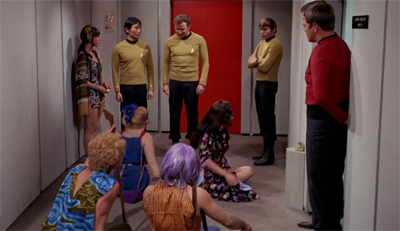
Kirk is hip to their games.
Sevrin is repeatedly described as “insane” over the course of the episode, a fact borne out in his stubborn refusal to abandon Eden even when it proves to be toxic. Indeed, The Way to Eden is careful to assure viewers that the classification of Doctor Sevrin as “insane” is not mere hyperbole. Instead, it is presented as incontrovertible fact. On consulting with the would-be revolutionary, Spock assures Kirk, “Doctor Sevrin is insane. I’ve not consulted Doctor McCoy, but I have no doubt of it.” Spock later references “a full psychological profile” of Sevrin suggesting as much.
Sevrin is shown to be callous and manipulative. Early on in the story, Sevrin is identified as the carrier of an extremely dangerous bacteria, one that can be treated using contemporary medicine. “Of course I knew,” he boasts to Spock. “You’ve researched my life. You’ve read the orders restricting me to travel only in areas of advanced technology because of what my body carries.” Spock responds, “What I fail to understand is why you disobey those orders.” Sevrin explains, “Because this is poison to me.”
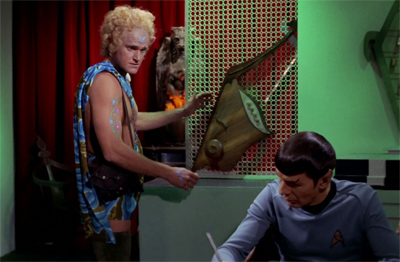
Who is pulling the strings?
Sevrin’s recklessness knowingly puts the lives of his followers at risk, even before he leads them to a toxic hellhole. Sevrin is not affected by the bacteria, but he knows that it will likely kill his followers if they do not take “full spectrum immunisations.” Given their desire to live away from technology, Sevrin must know that he carries something that would doom any primitive world that he chose to visit. “There wouldn’t have been enough primitives left to bury their dead,” McCoy bitterly reflects of Sevrin’s long-term plans. But Sevrin is so selfish that he doesn’t care.
Of course, there is also a sense that the bacteria serves as an extended metaphor for what makes Sevrin so dangerous. “He carries the disease and spreads it to others,” McCoy tells Kirk. The bacteria spreads from Sevrin, even though it does not affect him. Similarly, Sevrin’s politics and beliefs infect those around him, even if he is much more cynical and hypocritical than he pretends to be. Sevrin’s ideas are contagious, inspiring young minds to dangerous antics. After all, it is Sevrin who leads his followers to hijack the Enterprise and potentially start a war with Romulus.
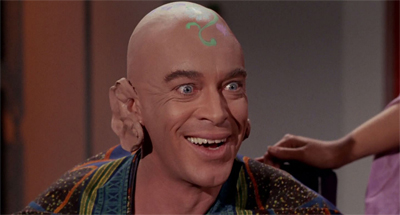
“You might laugh now, but big ears are going to be all the rage for Star Trek villains in 1987. I can feel it now.”
In fact, Sevrin rather brutally conspires to murder the Enterprise crew after he finds his way to the planet surface. He initially attempts to mislead his followers as to his intentions. “Well, I’m using sound against them, beyond the ultrasonic,” Sevrin explains. “It will stun them and allow us time to leave.” Naturally, sound is a weapon to Sevrin, just as words have been. However, Irina sees through Sevrin’s bluff, “Sound pitched that high doesn’t stun, it destroys.” Tad agrees. Sevrin acknowledges as much, “We cannot allow them to come after us.”
Sevrin is effectively cast as a pied piper figure, leading an entire generation of young people towards danger and death while on his own ego trip. The Way to Eden is entirely sincere in this regard, presenting Sevrin as a delusional psychopath who cares about nothing beyond himself and his followers as shallow fools who are easily mislead. It is very much the way that many parents saw the counterculture movement as a whole. (Sevrin, to a certain extent, fits the template that would seem tailored to Charles Manson upon his arrest in August 1969.)
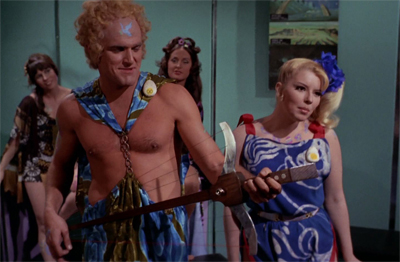
Adam played gui– or whatever the hell that thing is.
In some ways, The Way to Eden seems at least a little sympathetic to its subjects. It is certainly less aggressive in its condemnation of the movement than And the Children Shall Lead had been. As Aniko Bodroghkozy contends in Groove Tube, this was a relatively positive portrayal of hippiedom in the context of the late sixties:
More positively, the narrative opened a space for sustained attack on conformist technological society. The Way to Eden, unlike the vast majority of Star Trek episodes, questioned and challenged the benefits and superiority of the technocomputerised universe put into place by the supposedly utopian United Federation of Planets. Spock’s position as ally to the space hippies, against a fairly unattractive Kirk, strengthened and, to some extent, legitimised the critique. By displacing the ideological dispute into the future and, for the most part, dispensing with the issue of drugs (except at the end – and, even then, only punningly), the episode allowed for a reading of the counterculture and its rebellion against the dominant social order that was equivocally sympathetic.
Certainly, the suggestion that Spock is sympathetic to the space!hippies helps smooth over the more reactionary tendencies. Spock was very much the show’s breakout character, and frequently positioned as the voice of reason on Star Trek. The fact that Spock does not dismiss the space!hippies immediately (and pithily) suggests some measure of sympathy for the movement.

Playing along.
After all, Spock joins Adam for a “session” in the messhall, demonstrating that his is groovy. “What makes you so sympathetic toward them?” Kirk asks Spock at one point. Spock responds, “It is not sympathy so much as curiosity, Captain. A wish to understand. They regard themselves as aliens in their own worlds, a condition with which I am somewhat familiar.” In fact, it is that attribute that had served to make Spock so compelling and so fascinating to the counterculture in the first place.
Over the course of the show’s run, Spock had seen himself transformed into the most unlikely of sex symbols and countercultural icons. After all, Spock was at least as much a military man – and embodiment of the establishment – as James Tiberius Kirk. With his emotional detachment and stoic demeanour, Spock was far removed from the idea of “free love.” However, his alien nature spoke to an entire generation of viewers. Episodes like The Naked Time and Journey to Babel suggested Spock’s domestic situation was one with which many younger viewers might identify.

It’s okay, space!hippies, Spock can reach you.
To be fair, this reading of Spock is not entirely consistent and convincing. As Ina Rae Hark points out in the BFI guide to Star Trek, this counter-cultural version of Spock was largely a reimagining and reinvention of the half-Vulcan’s character:
As the series progressed and Spock became a counter-culture icon, his advocacy of deadly expediency waned and his non-violent temperament took precedence. Leonard Nimoy introduced the Vulcan neck pinch so that Spock, a vegetarian, would not engage in fistfights. Since so much violence is the result of overheated passions which Vulcan logic holds in check, this makes perfect sense. Unlike humans, Vulcans don’t ‘kill without reason’.
After all, Spock could be quite brutal and ruthless when the situation called for it. He advises Kirk to kill Gary Mitchell in Where No Man Has Gone Before, and insists on destroying the Romulan ship in Balance of Terror. He assures Kirk that Edith Keeler must die in The City on the Edge of Forever.

“Kids these days, with their space!rock and their space!roll.”
There is a sense that Spock was very much “softened” over the course of the three-year run of the series, allowed to mellow out a little bit. Of course, there are moments when Spock’s callousness and calculating nature can shine through; he seems ready to kill the kids in And the Children Shall Lead and cynically seduces the Romulan Commander in The Enterprise Incident. Nevertheless, the use of Spock as the token “cool” member of the Enterprise crew in The Way to Eden speaks to how counter-culture had embraced Spock and how Spock in turn embraced it.
Spock seems to genuinely believe in what these young people are trying to accomplish. “I can use the resources of the Enterprise to determine whether or not Eden actually exists and to plot its exact location,” Spock promises Sevrin early in the episode. It is not merely a ruse to get Sevrin to cooperate. Spock tells Kirk, later in the episode, “I made a promise which I should like to keep. With your permission, I must locate Eden.” Later, when the space!hippies hijack the Enterprise, it is Spock who tries to appeal to them by acknowledging their beliefs.

‘Ear him out.
“Adam,” Spock appeals. “You know I reach you. I believe in what you seek. But there is a tragic difference between what you want and what he wants.” Of course, Spock’s use of the space!hippie terminology “reach” makes him sound like a dad trying to be cool. Nevertheless, the point stands. Positioning Spock as an ally (in spirit) to the space!hippies represents a quasi-endorsement of their position. In many ways, it is a striking position for Star Trek to take, given how reactionary the show could be in episodes like And the Children Shall Lead.
At the same time, there is also something very patronising about all this. Painting Sevrin as a narcissistic psychopath is a very effective way to discredit the movement and its ideology, something that The Cloud Minders had touched upon with Plasus’ fixation upon “disruptors” as the cause of social unrest on Ardana. In the real world, many politicians had sought to discredit the labour industry and the civil rights movement by suggesting that they were largely driven by communists.

This sort of things is his bag, baby.
This line of attack allows for various social movements to be completely dismissed and ignored, a lazy smear that is used to invalidate the root causes and justified complaints that such organisations have. As much as Spock might claim to support the young space!hippies in their pursuit of Eden and their desire to create their own utopia, recognising the intrinsic worth in those ideas, would any of those young people have ventured forth in search of a better life without Doctor Sevrin to inspire them? Attacking Sevrin is a way to undercut the group.
More than that, there is something incredibly patronising in the way that The Way to Eden treats the young space!hippies. They are presented as incapable of independent or critical thought, waiting for direction from Doctor Sevrin and more loyal to one man than to the ideals of their movement. When Sevrin asks them to hijack the Enterprise, they do so blindly. When Sevrin plots to murder the entire crew of the Enterprise, they object momentarily but quickly go along with it. The space!hippies might not have a bad core idea, but they are dangerous idiots.

Frankly, my dear, I don’t give Adam.
In fact, there is something very reactionary in how The Way to Eden treats these ideas as inherently and unquestioningly dangerous. The Way to Eden seems worried about the potential effect that such beliefs might have on society as a whole. In many ways, it recalls the reactionary subtext of Let That Be Your Last Battlefield, which suggested that Lokai’s criticisms of institutional racism were valid, but his decision to act against them (and to constantly voice them) was just as responsible for tearing his society apart as the racist policies themselves.
The Way to Eden has its space!hippies hijack the Enterprise during a “session” in the messhall. Adam plays a song and dances, while Spock plays the lyre with accompaniment from another member of the group. The concert is broadcast on the ship’s intercom, and various members of the crew are shone to appreciate the anti-war songs. The redshirt guarding Sevrin is swinging his head. A redshirt on the bridge is playing air guitar. Even Sulu seems to sway to the rhythm that those hip cats are playing. Who could object to such funky music?

“Hey, the kids are all right.”
It’s a trap! That sweet smooth soul music is all an elaborate ruse to catch the Enterprise crew off guard while those sneaky space!hippies hijack the ship. The guard bopping to the song while guarding Sevrin? He is easily ambushed by Rad, who takes the opportunity to free Sevrin. Sulu is having such a good time that he does not realise that the space!hippies have seized control of the ship from the auxiliary control room. Those space!hippies used their pacifist jams to lure the crew into a false sense of security and then bam!
There is something quite knee-jerk and distasteful about this sequence, which seems to suggest that the counterculture movement is really just trying to lull the establishment into thinking they are a bunch of pacifist idealists before springing some sort of radical coup d’état. There is a stubborn refusal to accept that a bunch of pacifists singing some corny anti-war songs might just be a bunch of pacifists singing some corny anti-war songs. It is an episode that would seem to agree with President Richard Nixon, who saw Timothy Leary as “the most dangerous man in the world.”

Productivity was down after Sulu picked up those brownies in the space!hippie bake sale.
To be fair, there were always limits on how truly progressive Star Trek was willing to be. For every episode protesting Vietnam like A Taste of Armageddon or Errand of Mercy or The Trouble with Tribbles or Day of the Dove, there was another supporting it like Return of the Archons or Friday’s Child or The Apple or A Private Little War or For the World is Hollow and I Have Touched the Sky. Despite the show’s carefully cultivated reputation as progressive and liberal, there was always a reactionary impulse buried within Star Trek.
The show might push the edges of liberal progressivism, but it always pulled back. Let That Be Your Last Battlefield made a number of very clever observations about how inequality did not end with the abolition of slavery, but it tempered those observations by condemning those who protested such inequality as much as those who perpetuated it. The Cloud Minders explored issues of class and economic distribution, but insisted on a trite ending where all of those problems were solved by issuing slave labourers with gas masks.
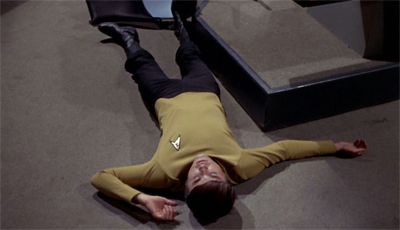
Turn on, tune in. Chekov’s out.
Allowing for the most charitable reading of the episode, The Way to Eden does something very similar. It expresses sympathy and understanding to the members of the counterculture movement, the people who feel left out of modern society and object to the direction that contemporary culture has taken, but it treats their ideas as inherently dangerous to the established order of things. There is an underlying conservatism to the episode, one that suggests Kirk might have been better served just to lock up those damned space!hippies, diplomacy be damned.
The twist ending is particularly barbed. Sevrin leads his followers to a planet that is actively hostile to human life. The first body that the away team encounters is Adam, who has died taking a bite from a poisoned fruit on a planet called Eden. Even more than This Side of Paradise or The Apple, the ending of The Way to Eden rejects the idea of utopia. As in a lot of third season episodes, there is a strong sense of apocalyptic dread running through the conclusion to The Way to Eden. Even the most beautiful of worlds is deadly; to enter paradise is to die.

Engineering a takeover.
Then again, this sense of doom and gloom rather accurately reflected both the anxieties of the late sixties and also the mood among the show’s production staff. The third season of Star Trek was always on borrowed time, having been improbably resurrected by a fan campaign at the end of its second season. The third was always going to be the last. According to guest star Deborah Downey interviewed by Starlog, the production team knew it was the end of the line:
“It was a very friendly place to work,” Downey recalls, “but I’m sure from their side, it probably wasn’t as comfortable as it was for me. The series was cancelled by that time. The cast and crew knew Star Trek was dead in the water, but they still had four more [episodes] to go. I sensed a depression on the set. It was Thanksgiving ’68, and Lee Meriwether had just been injured on the [nearby soundstage] set of Mission: Impossible. She was a friend of theirs, because she had done a Trek [That Which Survives] a little before mine, so they were quite upset that she was hurt.”
News that Star Trek would not be renewed for a fourth season was not officially confirmed to the public until February 1969, when NBC published their schedule for the coming year. However, those working on the show know that the production’s days were numbered. After all, NBC had delayed in confirming the order for the last eight episodes of the season, slotting in an interim order for The Mark of Gideon and The Lights of Zetar before confirming the final six.

One of the episode’s nicer touches is the fact that Scotty seems to (for no reason explored) have a pathological mistrust of space!hippies.
It goes without saying that this was not an optimum working environment for anybody involved in the production of the show. After all, it was not as if the show wasn’t already under pressure from a number of different sources. Leonard Nimoy had already decided that he did not want to remain a part of any hypothetical fourth season. William Shatner was going through a divorce, and going through a conflict with Nimoy over who was actually the lead on the series. Veteran directors like Marc Daniels and Ralph Serensky had left.
This is to say nothing of the pressures facing producer Fred Freiberger behind the scenes. Tighter budgets forced less location work, more modest sets, more bottle episodes and tighter schedules. While it could be argued that some episodes like Spectre of the Gun and The Tholian Web found ways around these restrictions, they were the exception. Veteran staff members like Gene Roddenberry, Gene L. Coon, Dorothy Fontana and Robert Justman were no longer available to support Freiberger. Things were not healthy.
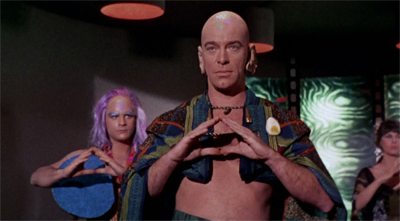
Pyramid schemes.
There was also a palpable sense of disappointment in the work that was being produced. Leonard Nimoy had strenuously objected to creative decisions in episodes like Is There in Truth No Beauty? and Whom Gods Destroy. In an interview with Starlog, guest star Phyllis Douglas suggested that nobody on set was particularly enamored with The Way to Eden:
“I was embarrassed to be in that one,” Douglas confesses. “If you watch the episode, you’ll notice that I hide in every single scene! I did Galileo Seven first, and I was really proud of that show, so I was excited to be in another one. After I got the job on Eden, I learned that the space hippies were going to sing. I thought, ‘Singing on Star Trek? That’s absurd!’ I just knew it wasn’t going to work.
“It was really funny, because when I was on the show, several regular cast members came up and told me how embarrassed they were, because Eden was the worst episode they ever made! I realized that as soon as I read the script. It was a dumb song, too. Unless you know me well, you won’t recognize or see me too clearly in that episode. I just hid!”
Indeed, various actors working on the show took the time to trash the episode in their memoirs. James Doohan suggested in Beam Me Up, Scotty that he considered recusing himself from the shoot. In many ways, The Way to Eden is treated as one of the most embarrassing moments in the entire run of the show. It is one of several episodes, like Spock’s Brain or And the Children Shall Lead, that is used to illustrate all that is wrong with the third season.

Music to their ears.
It is easy to point to ridiculous elements in the episode. The space!hippie terminology is absurd, to be frank. “Reach” is used instead of “dig”, while “Herbert” is used as an insult. It all seems to be trying a little too hard, right down to giving the space!hippies musical instruments that recall a crucified guitar and a bicycle wheel. The Way to Eden is an episode with no less than three musical interludes, which is quite striking for an episode of Star Trek. It is very easy to mock, and none of it is particularly good of itself.
However, the real problem with the aesthetic of The Way to Eden is that it does not go far enough. The episode is far too transparent in what it is trying to do, transforming hippie subculture into something half-alien. Star Trek audiences love weird details in their alien cultures. The Klingon language is built from having actors in ridiculous make-up bark consonants at one another, for example. Nobody complains too hard about Klingons singing in episodes like Melora or The Way of the Warrior. Fans (and even casual viewers) appreciate world-building.
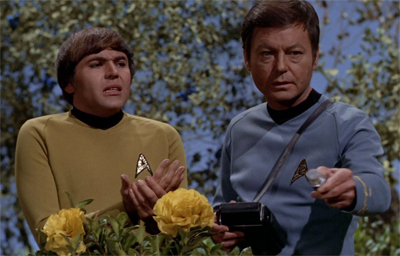
“Dammit, Mister Chekov. Did you learn nothing from The Apple?”
The problem is not that the space!hippies in The Way to Eden are ridiculous. After all, Star Trek has done ridiculous aliens before. Orion Slave Girls are beautiful women covered in green paint, while Andorians have white wigs and blue antennae. The problem is that The Way to Eden is trying way too hard to ensure that the audience knows what it is doing. The Way to Eden is incredibly condescending and patronising in crafting its central metaphor. It is thunderingly obvious. The first thing that the space!hippies do on arriving on the Enterprise is stage a sit-in.
More than that, the look and feel of The Way to Eden is surprisingly bland and dull for a television episode episode that can be reduced to the sentence “a bunch of space!hippies hijack the Enterprise and fly it to Eden.” Given the beautiful production design associated with Star Trek, thanks to Matt Jefferies and William Ware Theiss and Fred Phillips, it is surprising that The Way to Eden looks so plain and so bland. The space!hippie characters are colourful, but they are really just variations on the kind of hippies who were appearing on the nightly news.
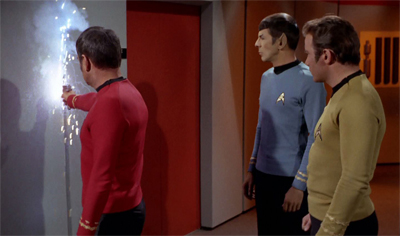
Sparking mistrust.
The third season of Star Trek is largely notable for how skilfully the production design and aesthetic can elevate weak scripts. The Cloud Minders is a clever premise and clunky teleplay, but it looks absolutely beautiful. Whom Gods Destroy is striking to look at, even as it refuses to make any sense. The third season is populated with memorable and striking visuals that demonstrate just how much craft went into the show, even with the budget cut. Even bottle episodes like Elaan of Troyius had striking imagery.
The Way to Eden is quite simply visually unimaginative, as it is narratively unimaginative. It is bland. It is generic. It is predictable. Indeed, this is a recurring detail that ties together the weakest episodes of the season. Spock’s Brain is a terrible episode, but it looks and feels incredibly cheap. And the Children Shall Lead has a singular memorable image of Melvin Belli in a sparkling silver dress, but that alone is not enough to sustain fifty minutes of television. The third season of Star Trek is at its worst when none of the elements work at all.

Fools Russia in.
The Way to Eden is notable for devoting attention to the character of Pavel Chekov. In fact, this is the episode which eventually reveals Chekov’s first name. Neither Uhura nor Sulu would get first names until the feature film franchise. In that respect the episode is remarkable. However, The Way to Eden does nothing particularly interesting with the character of Chekov. It offers no unique insight into the strange little navigation-slash-science officer. It seems to exist purely so that Walter Koenig cannot claim that he was never given anything to do.
In a way, this indicative of how Fred Freiberger approached characterisation. Freiberger really pushed the idea of romance on the show. The third season’s big McCoy-centric episode was For the World is Hollow and I Have Touched the Sky, in which the character got both a terminal diagnosis and hitched. Just a little earlier in the season, Scotty had his own moment in the sun with a love story in The Lights of Zetar. Neither love interest was ever seen (or mentioned) again.

“When’s our turn in the limelight?”
Of course, Walter Koenig had been itching for material throughout the season and the production team had tried to incorporate him into scripts like Spectre of the Gun. Quoted in The Fifty-Year Mission, Walter Koenig pointed to the episode as something of a monkey’s paw situation:
As a matter of fact, prior to that I had submitted a four-page statement of how I felt Chekov could be improved and made more multidimensional without subverting the story. Freiberger’s response was, “I read it. Forget it.” I knew the character was always going to be subordinate, but instead of spending the time pushing buttons, we could have spent that same thirty seconds on Chekov in a more fruitful way.
Even though he said, “I read it, forget it,” the episode was his way of giving me something and making Chekov a featured player. But I knew that it just wasn’t any good when I read it, and then the casting was terrible. They were all good actors, like Victor Brandt, but they were totally miscast. They’re supposed to be playing thirty-year-old flower children, hippie types, and they looked much rougher and much tougher than that.
There is something strange in the way that The Way to Eden characterises Chekov by making him a stickler for authority and order. Chekov had been introduced as a character intended to court young viewers, yet he seems more hostile to the space!hippies than anybody on the ship other than Kirk and maybe Scotty.

“Hey, at least we get a goodbye scene. That’s more than Romaine got.”
Of course, The Way to Eden was never intended to focus on the character of Chekov. The Way to Eden is the final episode of Star Trek to originate with writer Dorothy Fontana. Fontana is one of the best writers in the history of the franchise, and her distance from the third season likely a major role in the season’s creative inconsistencies. Fontana had stepped aside as story editor at the start of the year, but had agreed to contribute a number of scripts to the season. She had not been happy with how The Enterprise Incident was treated, but she kept her word.
While working on That Which Survives, Fontana pitched the story that would develop into The Way to Eden. However, her original pitch did not centre on Chekov as a character. It also did not place as much emphasis on the idea of space!hippies as the centre of attention. Fontana pitched a story that seemed to be much more character-driven, focusing on a familial dynamic for one of the leading trio. Even if that didn’t sound like Journey to Babel, there would be a lot to be excited about.

“Jim, it appears he was bludgeoned to death by a belaboured metaphor.”
Fontana explained her original pitch to Starlog:
“The Way to Eden was originally called Joanna, who was Dr. McCoy’s daughter, but the producers didn’t care for that idea,” Fontana reveals. “Instead, they made the character Chekov’s Russian girl friend, and then they shifted the story’s focus. I’ve never seen the episode.”
Joanna would never actually appear in Star Trek, but she is mentioned in The Survivor.

Adam ate of the poisoned fruit.
In many ways, Fontana’s script suffered from the defining aesthetic of the Fred Freiberger era. Freiberger was very invested in the idea of giving his cast material with which they might work. There was a conscious effort in the third season to spread a little attention around to bit players like Chekov and Scotty and McCoy. However, there was never any emphasis on what made these characters unique. There was nothing in those stories focusing on those characters that spoke to or about them.
McCoy is a great example. McCoy finds out that he is dying in For the World is Hollow and I Have Touched the Sky. That should be a beautiful moment for character reflection and introspection. Does McCoy regret that his relationship with his daughter didn’t work out better? Does McCoy rush into Natrina’s arms because he never made peace with his divorce? There are all sorts of interesting ideas there very specific to who McCoy actually is, but none of them make into an episode that treats the love story as strictly generic.

Materialistic concerns.
Fontana’s original pitch for Joanna sounds quite lovely, actually:
“I had gotten out of the show because I realized that the people running it — not Gene Roddenberry, he removed himself — but the people running it did not know the characters,” Fontana said. “What became The Way to Eden was originally a story called Joanna. It was about Dr. McCoy’s 22-year-old daughter and, after having been away from her because of his space missions, etc, for a number of years, he’s now introduced to his 22 year-old grown up daughter, who is a nurse. So, she’s in his profession and she’s kind of a stranger to him, and he is a stranger to her. How do they react?”
Her treatment of the episode is interesting, although maybe in need of some polish.

No fears, big ears.
However, Fred Freiberger was not interested in that story. In These Are the Voyages, Fontana offers her own version of events and how the story came to be jettisoned in favour of The Way to Eden:
“Despite the fact that Gene had liked and approved the idea of Joanna, Freiberger told me that McCoy was a contemporary of Kirk’s. … He did not know that De was playing it at least ten years older than Kirk. He as the senior member of the trio. He was the older, wise head. He was about 45, 46 then. So I knew [Freiberger] hadn’t even read the bible. Joanna is mentioned in the bible, because at the end of the first year I had spoken to De Kelley and said ‘I think we really need your character to have a grown-up son’, and he said, ‘Well, how about a daughter?’ And so we made it a daughter, in the nursing corps. McCoy and his wife had divorced, and [Joanna] and he had never spent too much time together — with him being out in space — and she grew up feeling kind of neglected. So she had a bone to pick with her father. … The basic idea of Joanna was that she comes aboard and Kirk starts paying attention and, suddenly, McCoy has to be a father. And, you know, he’s reacting like a father. And she says, ‘You don’t have that right! You may have contributed the sperm that brought me into being, but where were you when I was growing up?! Where were you when I needed a father?! I’m 21 now, get out of my face!’ … I thought that would have been a hell of a story, and so did Gene Roddenberry. But Fred Freiberger couldn’t see it because he thought that McCoy was the same age as Kirk.”
Fontana was already disillusioned with Freiberger over the changes that were made to The Enterprise Incident. The tinkering with Joanna was the last straw. Fontana abandoned both That Which Survives and Joanna to fate.
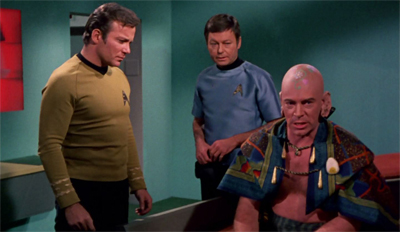
Not quite a treat(ment)…
It is a shame that this happened. Fontana is probably the best character to have worked on the original Star Trek, demonstrating an uncanny understanding of the crew and their psychology. There is a specificity to the way that Fontana writes characters like Spock, a care and craft that elevates even troubled scripts like The Naked Time and This Side of Paradise. That sort of specificity is sorely lacking from the third season as a whole. One need only look to John Meredyth Lucas’ attempts to channel Fontana’s voice for Spock in That Which Survives.
Given that The Way to Eden is such a spectacular mess, it seems fair to say that Joanna would almost certainly have been an improvement. In fact, the third season of a whole would likely have been much improved if Fontana and Freiberger had been able to work together instead of butting heads so spectacularly. More than David Gerrold or Margaret Armen, it was Fred Freiberger’s inability to establish a professional and cordial relationship with Dorothy Fontana that contributed to the troubles with the third season.

Et in Arcadia ego.
In Freiberger’s defence, every decision that he made was perfectly within his remit as executive producer. Freiberger made this argument during and interview with Starlog, in what occasionally feels like a very passive-aggressive swipe at Fontana’s difficulty accepting that she was just a writer and no longer the story editor:
Using the Harlan Ellison Star Trek script as an example… Roddenberry and Gene Coon rewrote his “City on the Edge of Forever” and Ellison submitted his first draft to the Writer’s Guild awards, and it got the award. Now, that doesn’t mean that the staff people were wrong in what they wanted to do, or that he was right. This is the nature of this business. If people come in to produce a show… Gene Roddenberry and Gene Coon or whoever, that show has to be shaped in terms of what they think. There are 1,200 active writers in the Writer’s Guild. Writers have fragile egos. The come in and submit something. You generally know your show better. You change that show; you rewrite the show. You suggest what they do. You make suggestions. The professional writer is one who has been in the business and knows what it is. No writer likes to have what he’s done changed. Some of them will accept the fact that some good suggestions are made and will follow the guidance of the people who are running the show. The writer comes to the producer and tells him the idea. The get the assignment. All are cut-off assignments, cut off after story. They then come in with the story and discuss it. They adjust. At no time does a writer have to, if he’s got such integrity, and I do not say that disparagingly, accept the change. All he has to do is leave and say, “Just pay me my money for that story and I’m finished.” They don’t have to go on with it after that.
The people who are running a show have to run that show. The can’t let 22 different writers come in and determine how the show should go. You’ve got to shape it, rightly or wrongly, ratings and otherwise. The average writer that I know, if he’s been around, he gets 50 percent up there on the screen.
Freiberger was a very traditional producer, an television veteran who understood the industry. He lacked a specialised understanding of Star Trek, and that was a major problem with his stewardship. Many of the people who could have guided him were absent, by their choice or his. Fontana was a major loss, no matter what the cause.

Also, yes. That is veteran character actor Charles Napier.
The Way to Eden is a disaster of an episode, a demonstration that Star Trek will not be finishing with its best foot forward. The end was in sight, but even that would prove to be somewhat toxic.
Filed under: The Original Series | Tagged: counterculture, dorothy fontana, fred freiberger, hippies, review, sixties, spock, star trek, Television, the way to eden |




















This is a great and exhaustive analysis of one of Star Trek’s most interesting (but least satisfying) episodes. Thanks for linking and quoting my own analysis of it.
It’s a good analysis! I think there’s very little new ground to be charted in exploring something as well-trodden as Star Trek, at least not without acknowledging and building (and sometimes even contrasting or comparing) the work done by others.
I don’t love this episode, but I don’t hate it as much as most Trek fans do, either. More clearly than any other TOS episode, it’s obviously a time capsule from 1968, and I find it completely fascinating from that point of view.
I was ten years old in 1968, so I remember some things about that era, though I wasn’t quite old enough to have a serious understanding of the political and social changes that were happening at that time.
In 1968, young people were taking over public buildings by sitting down and singing. The authorities had no idea how to handle this, and people were Very Concerned about What This Means For Our Civilization. Of course, from the perspective of 2016, the sit-ins of the 60’s are ancient history; we know that civilization managed to survive young people sitting down and singing. 🙂 But at the time, it was a big deal, and I like this episode because it reminds us of how things were seen at the time. It’s kinda laughable, in this day and age, to see authority figures Very Concerned about young people who were — *gasp* — sitting down and SINGING, and the whole episode reminds me of the innocence that we had — and lost — back in the 60’s.
Plus any episode that has Spock playing the Vulcan lute can’t be seen as a total loss. 🙂
The episode was rather heavy-handed in its condemnation of Severin, but then, TOS was frequently heavy-handed; I’ve learned to kinda hold my nose and overlook at least a percentage of the heavy-handedness. After all, even at its worst, TOS usually tries to be about something, and that’s so much better than most of what was on TV at the time. And as the Manson case would show, there really WERE some leaders who were psychopaths.
I really like what you have to say about Dorothy Fontana here. So many fans worship Roddenberry, without paying attention to what Fontana and Coon and Justman did for the show. Much of what people like about TOS wasn’t due to Roddenberry at all; it was the work of Coon and Fontana, but Roddenberry was so shrewd in propagating the “lone visionary” myth that many fans have bought into it.
I adore “Journey to Babel,” and I SO wish that Dorothy Fontana had been given the opportunity to do for McCoy in “Joanna” what she’d done for Spock in “Journey to Babel.” Really, I wish they’d locked up Roddenberry once he’d created Star Trek and given Coon and Fontana their heads; it would have been interesting to see what we’d have gotten. 🙂
Anyway, thanks for another thoughtful and insightful review!
Fontana is fantastic. And it’s great that she is still around and still an active participant in discussions and debates around the show. She recently wrote some comics for IDW, and she has given a few commentaries, and she still offers interviews talking about her work. In many ways, Fontana is very much the godmother to Star Trek, and I’m disappointed that she’s not appreciated anywhere near as much as she should be. Fontana is at least as responsible for the character of Spock as Leonard Nimoy, and yet is never recognised as much. (The same is true of Coon, who obviously was not involved for anywhere near as long owing to his premature death.)
While I’m generally quite sympathetic Fred Freiberger’s conflicts with other writers like Margaret Armen or David Gerrold, it’s the loss of Fontana which really cripples the third season. Had Fontana been convinced to stay, the third season would have been a lot more consistent in terms of quality. While a lot of that is likely down to the fact that Freiberger and Fontana simply didn’t seem to hit it off, and seemed antagonistic from the first, I wonder whether some of the blame lies with veterans like Roddenberry or Justman.
(Roddenberry certainly had Freiberger’s ear at the start of the year, as demonstrated by Freiberger’s attitude towards comedy in the first half of the season and the fact that Freiberger pressed ahead with episodes like Elaan of Troyius or The Paradise Syndrome despite his apparent ambivalence towards the latter. And Justman seems to have had some influence on Freiberger’s attitude to David Gerrold. Freiberger himself has conceded that he had no idea what he was doing when he started on the show. I’m surprised that Roddenberry or Justman didn’t champion Fontana more, to the point that These Are the Voyages… suggests that they all but ignored her protests on The Enterprise Incident. But then we’ll probably never know the day-to-day person-to-person reality of the internal workings.)
Watching The Way to Eden?
Ohhhh, brother.
>Leonard Nimoy introduced the Vulcan neck pinch so that Spock, a vegetarian, would not engage in fistfights.
This conjures up lovely images of a pre-vegetarian Spock gnawing the flesh off his enemies’ bodies.
All the episode is missing is Joe Friday lecturing the kids on their life choices. And yet it’s *still* given call-backs in the franchise via DS9’s “The Ship!”
But all these years later, we still don’t know who Herbert is…
We do, actually. Herbert Solow was listed as “Executive in Charge of Production” for the first two years of TOS; he’s also the primary author of the book Inside Star Trek: The Real Story. Using “Herbert” in this episode was said to be a friendly way of teasing Herbert Solow for being the “authority” on the studio lot.
Good spot! I had wondered that myself. Didn’t Richard Arnold go on to suggest that there was some bad blood between the production team and Solow, to the point that he wasn’t invited to the party celebrating Roddenberry’s star on the walk of fame?
I thought it might be a reference to the 1968 Democratic nominee, the Vice-President to Lyndon B. Johnson, given the way that convention turned out to be a flashpoint for the chaos of 1968; but it turned out that I was misremembering “Hubert” Humphrey as “Herbert” Humphrey. Bah.
To be fair, Ira Steven Behr and Robert Hewitt Wolfe love their callbacks, even when those callbacks are not necessarily the best idea.
I always saw this episode as the Star Trek equivalent of Reefer Madness. Both have an extremely condescending attitude to some they don’t really understand. Heck, both even have random odd musical numbers.
That’s a pretty apt comparison. I’m surprised that there’s wasn’t an accompanying PSA with Kirk and Spock in character.
“You might laugh now, but big ears are going to be all the rage for Star Trek villains in 1987. I can feel it now.”
Heh.
Neat review as ever Darren. This is actually one I do recall, and how bizarre it was.It is quite interesting looking back however to see the way a similar story was told in ‘Star Trek V’. We have an expedition to find paradise led by a charismatic guru with a key link to Spock. Sybok is just as manipulative as Sevrin, but treated much more sympathetically, almost tragically. I wonder whether that was a concious reappraisal or if was largely a coincidence they played of similar beats.
By the way the musical interludes positively drip Sixtyness don’t they? A couple of years ago I saw a lot of ‘I Dream of Jeannie’ on TV (kind of a fascinating insight into period pop culture and – this is going to sound weird – in some ways much more progressive than the held in higher regard ‘Bewitched’). Aside from having at least two hippie episodes, one episode stopped the plot for four full minutes for a Don Ho interlude! It wasn’t even part of the plot, the main characters just walked into a night club, watched him perform and otherwise didn’t interact with him. I realise I’m talking about a sitcom based on an astronaut and three thousand year old genie being a couple but that really was surreal.
The sixties were a weird time for television, weren’t they?
I say, eagerly awaiting a prestige television so about killer robot cowboys in a futuristic theme park.